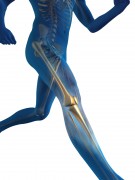Preparing For Seasonal Affective Disorder
It's been a fantastic Fall so far in British Columbia, Canada, where I dwell. It's nice and sunny and has made me smile. And now it is pouring rain. And I like rain, the sound of it hitting my skylights, but I do not like the slow change in my mood that never seems to forget about me each year. And each year, I am somehow surprised that Seasonal Affective Disorder (SAD) has slowly inched its way into my life---again-- and each year, my mood seems to fall along with the leaves.
Difference Between 'Winter Blues' and Seasonal Affective Disorder
 Many people experience a dip in mood during the darker months. As the days become shorter and pasta becomes preferable to summer salad, human beings like to hibernate. But experiencing a lower mood during these months is not the same as living with SAD. Seasonal Affective Disorder occurs more frequently when people struggle with an existing mental illness.
Many people experience a dip in mood during the darker months. As the days become shorter and pasta becomes preferable to summer salad, human beings like to hibernate. But experiencing a lower mood during these months is not the same as living with SAD. Seasonal Affective Disorder occurs more frequently when people struggle with an existing mental illness.
Common Symptoms of SAD:
- A shift in energy; lower energy and/or motivation
- A change in eating habits; eating more or less
- A change in sleeping patterns; sleeping more or less
- A feeling of detachment; confusion and less interest in activities that were once pleasurable
- Sadness; a feeling of hopelessness
- Difficulty concentrating
- Withdrawal from family and friends
These symptoms mimic those of a depressive episode but in the case of SAD, they are directly connected to a change in seasons. It's important to note that while the condition occurs more frequently during the winter months, some people suffer in the warmer months.
Preparing For Seasonal Affective Disorder
 Despite my always being surprised when the season brings me to my knees, I do plan ahead. My psychiatrist and I integrate a plan each September and the steps I take, the techniques many people with SAD employ, are successful--not completely, but they certainly help
Despite my always being surprised when the season brings me to my knees, I do plan ahead. My psychiatrist and I integrate a plan each September and the steps I take, the techniques many people with SAD employ, are successful--not completely, but they certainly help
- Light Therapy for SAD is no longer considered a "new-age" approach (it has been used for over twenty years!) to treat SAD but used often
- Exercise! I know, I know...It's hard to exercise when we feel depressed but I always feel better after. Just twenty minutes a day can increase our mood
- Try to regulate our sleeping patterns
- Discuss medication alterations if need be. I usually increase my antidepressant dosage when Fall rolls around
- Managing your stress level
- Communicate with those in our inner circle; communicating with your mental health team
- Group therapy
There are many approaches to treatment of Seasonal Affective Disorder and it's useful for us to share what works with one another.
If you experience SAD, what works for you?
APA Reference
Jeanne, N.
(2012, October 4). Preparing For Seasonal Affective Disorder, HealthyPlace. Retrieved
on 2025, December 9 from https://www.healthyplace.com/blogs/recoveringfrommentalillness/2012/10/preparing-for-seasonal-affective-disorder
Author: Natalie Jeanne Champagne
I was eating gnocchi at my desk when I found this article. Definitely feeling that pasta shift! Made me laugh out loud. :)
I noticed you suggested managing stress. I found a way to manage my stressful feelings and thoughts that really worked for me. Just sharing it in case you or anyone would like to check it out.
http://winterbritt.com/2017/09/28/things-know-true-rules-need-live/
I was also really attached to my daylight lamp back when I was depressed. thanks again!